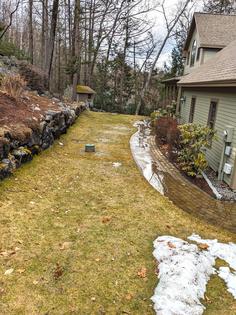Ask the Builder: Don’t sign contracts for unneeded work
Two days before writing this column, I saved an Ohio homeowner $30,000. He had stumbled across my website, and he saw that I consult with readers on the phone. Water was ponding against his house foundation, and he was considering signing a contract with a waterproofing company for the above amount.
Once I studied the photographs he sent me, I asked him if he was sitting down. "That ponding water is NOT causing the problem you’re having," I told him. "If you had signed that contract, you would have wasted all that money.”
There was stunned silence at the other end of the phone. I discovered moments later I was hearing the sound of relief! This man had been suffering angst about the huge cost for over a year! A wave of gratitude was washing over him as he realized he wouldn't have to raid his retirement savings.
Ponding water is not a good thing. I’ll discuss in a few moments how to prevent it or deal with it if you have the same problem. For now, let’s talk about the problem my caller had.
The man told me that he had discovered, quite by accident, that the bandboard that caps the ends of his floor joists was rotting. I could see from his photographs that the bandboard was at least 16 inches above the soil around his foundation. The ponding water could not leak into his house and contact these boards.
I asked if he had any signs of water leaking into his basement. His answer was no. After asking a few other questions, I said: “The wood rot you’re experiencing is caused by condensation that’s forming in the winter months on the cold wood. The moisture can’t easily evaporate because of the 6-inch thick pieces of fiberglass insulation that are placed in contact with the wood.”
I advised him to remove all the fiberglass, which would allow the wood to dry. I then shared a few methods to repair any severe rot. Once the wood was dry and all repairs were complete, I instructed, he should install 4 inches of closed-cell foam insulation. This rigid material must be custom cut and fit tight between the floor joists, subfloor and sill plate. Once in place, a spray can of expanding foam should be used to fill any small cracks between the wood and the foam. The closed-cell foam would prevent water vapor from contacting the band board in the future.
We then discussed why the water was ponding against his house. He admitted he caused part of the problem at the front by installing raised landscape beds. I told him this was not a good idea. Unfortunately, many landscapers don’t understand the minimum requirements set forth in the uniform building code.
The minimum grading standards in the code state that the ground must slope down and away from each foundation wall at least 6 inches in the first 10 horizontal feet of distance away from the foundation wall. What’s more, the code states that a minimum of 6 inches of foundation must extend above the ground that touches the foundation.
Do the math. This means the top of a foundation wall should be a minimum of 12 inches higher than the ground that’s 10 feet away from the foundation. Houses built on hillsides have a difficult time satisfying this requirement on the uphill side of the house.
...continued







